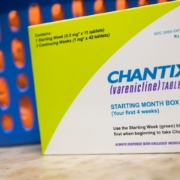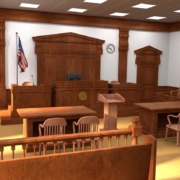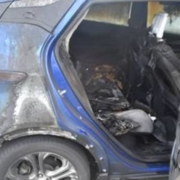Chantix Voluntary Recall
Chantix has been the go-to drug for 15 years for people finally trying to end their cigarette addiction. The Pfizer drug is taken for up to 24 weeks and works by blocking receptors in the brain that make the smoker associate nicotine with pleasure.
Eventually, the smoker feels less of an urge to smoke, and the symptoms of nicotine withdrawal decrease.
Chantix, which has always been controversial, has reached its last stumbling block. On September 16, drugmaker Pfizer announced it would recall Chantix (varenicline), both 0.5 mg and 1 mg tablets.
Patients are urged to seek an alternative medication.
Background
The recall is due to nitrosamine, N-nitroso-varenicline, found in the tablets above the federal acceptable intake limits. Long-term exposure to nitrosamine, N-nitroso-varenicline is linked to a potential cancer risk in humans.
Nitrosamines are ubiquitous – found in grilled meats, food, dairy products, cigarette smoke, drinking water, and vegetables. They have no use in industry but are sometimes found in processed foods, likely resulting from a reaction between nitrates and nitrites. They are thought to be a disinfection byproduct and are considered a potent carcinogen that may produce cancer in the lung, brain, liver, kidney, esophagus, bladder, stomach, and sinus.
The U.S Food and Drug Administration (FDA) is between a rock and a hard place. Smoking is a known environmental carcinogen, and Chantix does seem to help smokers quit. Twenty-two percent of smokers quit smoking after 12 months on Chantix, which was slightly better than other nicotine replacements.
Tobacco use causes more than seven million deaths a year. The Centers for Disease Control and Prevention (CDC) reports more than 16 million Americans live with a disease caused by smoking.
Controversial History
Chantix has been linked to aggressive behavior, psychiatric events, and depression since entering the U.S. market.
When the Institute for Safe Medical Practice (ISMP) found Chantix had more adverse events than any other drug on the market, the Federal Aviation Administration (FAA) released its health advisory that air traffic controllers and pilots were banned from using the drug. Truck drivers were banned from its use, as were members of military missile crews.
The ISMP found that Chantix’s outbursts consistently had three characteristics: senseless and unpredictable violence and the victim was often chosen at random. People with no history of violence perpetrated the violence.
Chantix was blamed for the 2007 death of Carter Albrecht, a Texas musician who began experiencing hallucinations after drinking and taking Chantix during a violent altercation with a neighbor.
The shooting led to the black box warning on the label of Chantix in 2009 about hostility, aggression, depression, and suicidal thoughts. A black box is the most serious warning issued by the FDA.
The black box warning stayed in place until the FDA reviewed the results of an 8,000-person study that downplayed any psychiatric side effects among the users of Chantix, comparing them to those experienced by people using a nicotine patch. The FDA decided the black box warning could be removed.
In 2020, Pfizer sales for Chantix totaled $919 million.
Lawsuits were filed across the country over Chantix and its side effects, including suicidal thoughts, hostility, depression, and hallucinations. The victims allege the drug was not tested for mental health concerns before entering the market, even though Pfizer knew the potential for changes in behavior.
An MDL was formed in the Northern District of Alabama and dismissed in 2014 after a settlement of $300 million to about 2,900 plaintiffs.
The Recall
This summer, Pfizer paused the distribution in July, recalling 12 lots of the drug over the presence of nitrosamines. By August, another four batches were recalled. Safety monitoring had uncovered the carcinogen in the tablets.
By September, Pfizer voluntarily recalled Chantix 0.5 mg and 1 mg tablets that were put on the market from May 2019 to September 2021.
In explaining the move, Pfizer said its recall was precautionary. The company posted on its website:
“Chantix has a safety profile that has been established over 15 years of marketing authorization and through a robust clinical program,” “Pfizer believes the benefit/risk profile of Chantix remains positive…. People who smoke cigarettes are 15 to 30 times more likely to get lung cancer than people who do not smoke.”
There is believed to be no immediate risk to smokers who are still taking Chantix.
The FDA updated the recall in September, urging patients to continue taking their medication until they find a suitable replacement. Fearing a shortage, the FDA held that varenicline could continue to be distributed if the N-nitroso-varenicline levels fell between 37 ng per day but below 185 ng per day.
In Canada, Apotex distributed varenicline (generic Chantix) can now be imported in the U.S. for the interim. The FDA has opted to become flexible, allowing N-nitroso-varenicline up to 185 ng per day to avoid shortages or have patients return to smoking.
It’s unclear if this recall will become a permanent one or if Pfizer will once again start production. There are no reports of patients being harmed by the nitrosamines.
Manufacturers must follow the FDA guidelines on making and testing medications for nitrosamine impurities.
Other Drugs
The recall is not dissimilar from the Zantac recall from April 2020, where unsafe N-nitrosodimethylamine (NDMA) levels were found. That chemical is also associated with cancer.
Studies at the time showed that levels of the carcinogen could increase over time and when exposed to heat.
Blood pressure drugs valsartan and losartan also contain nitrosamines and have been recalled.
Lawsuits have been filed against the manufacturer claiming a manufacturing defect and a failure to warn. Those cases are currently consolidated in MDL #2875 in New Jersey District Court.
Sources:
Science Direct
https://www.sciencedirect.com/topics/neuroscience/nitrosamines
GoodRX
https://www.goodrx.com/chantix/chantix-production-halted
Wall St Journal
https://www.wsj.com/articles/fda-drops-stringent-warning-on-smoking-cessation-drug-chantix-1481918026?mod=article_inline
JPML
https://www.jpml.uscourts.gov/sites/jpml/files/Pending_MDL_Dockets_By_District-December-15-2021.pdf










